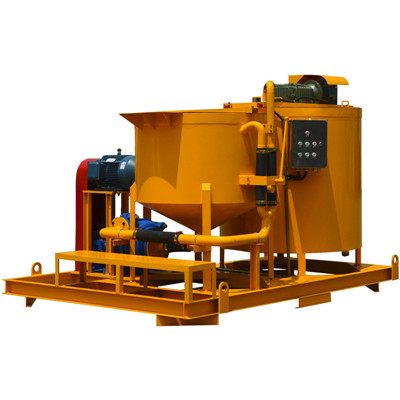Central Grout Mixing and Grout Pump Plants
As mentioned earlier, there are sites where carrying out all the grout mixing in one centralized location is obviously best. Examples include deep canyons without convenient access down the bottom, some underground work, sites where access around the job is too restricted to permit economical transport of bagged cement, and so on. In these, a central grout mixing plant sending the grout off in lines to agitators and grout pumps elsewhere can be a good solution. And, of course, setting up bulk cement facilities is usually worthwhile at such plants.The next stage in the use of centralized equipment is the central grout pumping plant; this not only mixes the grout but also pumps it off to the holes through circulation lines. The concept comes from chemical grouting where some quite complex plants have been used, particularly where the grouting has been in a compact area and has required intensive placement of holes, an example being tunnel grouting. However, the concept does not translate quite as well to cement grouting if the work is spread out over a wide area, such as a dam site. This is because unlike chemical grouting, cement grouted holes in a high-quality job should be individually grouted, with each hole receiving treatment appropriate to its particular grouting progress. To do this properly, each hole must have its own grout pump and circulation line all the way from the grout plant to the hole and back again (some comments about this follow shortly).This makes for a massive lineup of and a plethora of lines pumps over the site. Apart from their cost(they may be a matter of miles in total length), they have other problems:
1. lf earth-moving equipment is working on the site and passing over circulation lines, the lines must be protected by such methods as putting them inside larger steel pipes where they pass under haul roads or concentrated traffic areas. Even so, here lines wander across other areas, they can suffer a high casuality rate from the attentions of a certain mentality of earth mover driver who seem to get great delight from accidentally (on purpose?) flattening them.
2. Each hole must have its own circulation line, and in the large numbers usually involved, it is very easy to get them confused, so that the wrong line gets hooked on at times.
3. The volume of all these lines has to be filled with grout several times a day after each washout, and the cement used in doing this is wasted. The contractor is not usually paid for i, of course.
4. The grout pump reaching the hole is not as fresh as when mobile gear and short lines are used.
5. There can be difficulties in matching pressures in the lines with those required at the holes for the grouting.


